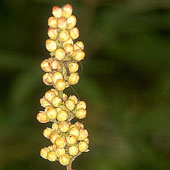Chasteberry
Keywords: chaste-tree berry, vitex, monk's pepper, premenstrual syndrome (PMS), breast pain, infertility

© James Manhart
On this page:
- Introduction
- What It Is Used For
- How It Is Used
- What the Science Says
- Side Effects and Cautions
- Sources
- For More Information
Introduction
This fact sheet provides basic information about the herbA plant or part of a plant used for its flavor, scent, or potential therapeutic properties. Includes flowers, leaves, bark, fruit, seeds, stems, and roots. chasteberry—common names, uses, potential side effects, and resources for more information. Chasteberry is the fruit of the chaste tree, a small shrub-like tree native to Central Asia and the Mediterranean region. The name is thought to come from a belief that the plant promoted chastity—it is reported that monks in the Middle Ages used chasteberry to decrease sexual desire.
Common Names—chasteberry, chaste-tree berry, vitex, monk's pepper
Latin Name—Vitex agnus-castus
What It Is Used For
- Chasteberry has been used for thousands of years, mostly by women to ease menstrual problems and to stimulate the production of breast milk.
- Chasteberry is still used for menstrual problems, such as premenstrual syndrome, as well as for symptoms of menopause, some types of infertility, and acne.
How It Is Used
The dried ripe chasteberry is used to prepare liquid extracts or solid extracts that are put into capsules and tablets.
What the Science Says
- A few studies of chasteberry for premenstrual syndrome have found a benefit. However, most of these studies were not well designed, so firm conclusions about chasteberry for premenstrual syndrome cannot be drawn.
- Small studies suggest that chasteberry may help with breast pain and some types of infertility, but there is not enough reliable scientific evidence to determine whether chasteberry has any effect on these conditions.
- NCCAM is funding studies on chasteberry. Recent projects have explored how chasteberry works in the body and how it might affect symptoms of premenstrual syndrome.
Side Effects and Cautions
- Chasteberry has not been associated with serious side effects. However, it can cause gastrointestinal problems, acne-like rashes, and dizziness.
- Chasteberry may affect certain hormone levels. Women who are pregnant or taking birth control pills or who have a hormone-sensitive condition (such as breast cancer) should not use chasteberry.
- Because chasteberry may affect the dopamine system in the brain, people taking dopamine-related medications, such as selegiline, amantadine, and levodopa, should avoid using chasteberry.
- Tell your health care providers about any complementary and alternative practices you use. Give them a full picture of what you do to manage your health. This will help ensure coordinated and safe care.
Sources
- Chasteberry (Vitex agnus castus). In: Coates P, Blackman M, Cragg G, et al., eds. Encyclopedia of Dietary Supplements. New York, NY: Marcel Dekker; 2005:95–103.
- Chasteberry. Natural Medicines Comprehensive Database Web site. Accessed on July 5, 2007.
- Chasteberry (Vitex agnus-castus). Natural Standard Database Web site. Accessed on July 3, 2007.
- Chaste tree fruit. In: Blumenthal M, Goldberg A, Brinckman J, eds. Herbal Medicine: Expanded Commission E Monographs. Newton, MA: Lippincott Williams & Wilkins; 2000:62–64.
For More Information
- What's in the Bottle? An Introduction to Dietary Supplements
- Herbal Supplements: Consider Safety, Too
NCCAM Clearinghouse
The NCCAM Clearinghouse provides information on CAM and NCCAM, including publications and searches of Federal databases of scientific and medical literature. The Clearinghouse does not provide medical advice, treatment recommendations, or referrals to practitioners.
Toll-free in the U.S.: 1-888-644-6226
TTY (for deaf and hard-of-hearing callers): 1-866-464-3615
Web site: nccam.nih.gov
E-mail:
CAM on PubMed
Web site: nccam.nih.gov/camonpubmed/
NIH Office of Dietary Supplements
Web site: ods.od.nih.gov
This publication is not copyrighted and is in the public domain. Duplication is encouraged.
NCCAM Publication No. D335
Created December 2006
Updated April 2008
Note: PDF files requires a viewer such as the free Adobe Reader.
